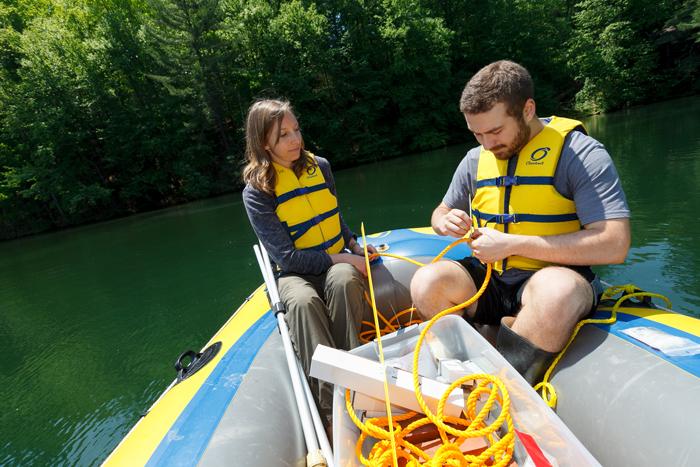When It Rains

Assistant Professor of Environmental Studies Kristin Strock and Max Egener '16 deploy high-frequency sensor buoys at Fuller Lake. Photo by Carl Socolow '77.
Student-Faculty Research Explores Effects of Climate Change
by Christine Baksi
When it rains, Max Egener ’16 hopes it pours. Why? Extreme rain events and specifically, how those events affect lake ecology, is the focus of his senior-thesis project.
“I’m interested in measuring the ecological effect of climate change on lakes,” he says. “Climate change means warmer air. Water evaporates more. Clouds form quickly and they hold more moisture, which leads to extreme downpours. How does that impact the physical, chemical and biological properties of lakes?”
To find the answers, he’s paired up with his faculty mentor, Assistant Professor of Environmental Studies Kristin Strock, an aquatic limnologist who has successfully completed similar projects in Maine’s Acadia National Park and Minnesota’s Isle Royale National Park. Together, they submitted a research-grant proposal to study the ecology of three lakes near campus that are popular spots for fishing, boating and other recreational activities. The project is funded by the Center for Sustainability Education and the Pennsylvania Department of Conservation and Natural Resources (DCNR) through the South Mountain Partnership.
The goals of the project are to provide insights into how storm events and weather affect water quality, provide lake managers with a more comprehensive understanding of the lakes’ ecologies and enhance communication to the public by producing signage for lake visitors. Potential signage topics include lake ecology and history, wildlife and a map with optimal fishing spots.
Stirring things up
Strock notes that the northeast United States has experienced the most substantial increase in storm frequency and severity of any region in the U.S. since 1950. Rain events can increase the delivery of sediment, organic matter and nutrients from the watershed that can reduce water clarity and influence aquatic communities. While the threat of these changes to water quality are potentially great, there is currently little information to inform lake-management strategies. “By partnering with DCNR, this new knowledge can help inform lake management now and in the future,” she says.
Strock and Egener are using cutting-edge technology to monitor the health and ecology of Laurel and Fuller lakes in Pine Grove Furnace State Park and the 59-acre Opossum Lake near Carlisle. Last month, they deployed high-frequency sensors at key locations in the three lakes. The sensors will supply lake managers with high-resolution temperature and oxygen data outlining the conditions of the lake in various habitat zones. Sensory data will be recorded every hour throughout the summer and be supplemented by Egener’s biweekly monitoring of lake chemistry and biological communities in the lake, such as algae and zooplankton.
Research suggests that extreme rain events can reduce water quality and more than double the amount of brown organic matter. To monitor that, Egener will collect water samples within 24 hours of each extreme rain event and again after 72 hours. Monitoring will continue through summer and until ice forms. In September, preliminary data will be analyzed and reported to lake managers.
“Information from Dickinson’s monitoring and research will be used to shape management efforts at our two parks,” says DCNR Secretary Cindy Adams Dunn. “For instance, knowing what is triggering an influx of sediment and nutrients will allow park and resource managers to develop more customized action or effort. Examples might be a focus on streambank stabilization within the park, or working with partners to make improvements on a larger, watershed scale outside park boundaries.”
Strock adds, “These lakes are important, heavily used resources in the South Mountain landscape. The results from this work will help us to understand and communicate how the lakes are functioning and how they might be changing over time.”
Learn More
Published June 9, 2015